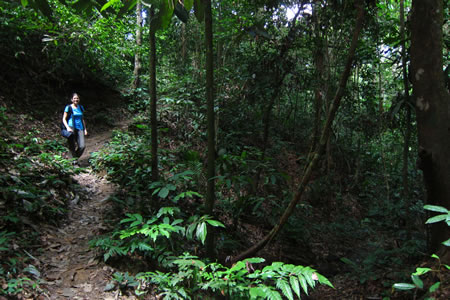

| Princes of the Land | |
Fraser's Hill (Malaysia) to Kuantan (Malaysia), April 2011 |
|
After spending almost two weeks in the beautiful environment of Fraser’s Hill, it was time for our next destination: Cameron Highlands. From Fraser’s Hill we took a taxi back to the town of Kuala Kubu Bahru, because of the lack of public transport to and from Fraser’s Hill. We asked the taxi driver to drop us at the railway station where we just caught the train to Ipoh, a couple of hours north of Kuala Kubu Bahru. Ipoh is a typical Malaysian town, not a lot to see, but it has preserved enough traditional Chinese shopping houses to make Ipoh a nice stop-over. After a relaxing day, we took the bus to Cameron Highlands, for many visitors one of the highlights of their visit to Malaysia. Cameron Highlands is a so-called hill station, a settlement in the cool mountains, built by the British to escape the heat of the lowlands. The main reason for people to come here, especially Malaysian tourists, is not only to escape the heat, but also to enjoy the tea-plantations and strawberry farms. We visited this area already in 2008, and by that time we weren’t really impressed by the beauty of the area. And to be honest, it didn’t change a lot. The main settlement Tanah Rata isn’t beautiful at all, the environment including the tea-plantations isn’t spectacular and the plastic greenhouses of the strawberry farms are extremely ugly. So, it is still a big question mark for us why people come here. Some locals even pay 20 Ringgit (around € 5) to pluck half a kilo of strawberries in one of the ugly greenhouses. And, oh yes, they also treat their children on all kinds of strawberry knickknacks, like strawberry ear warmers, strawberry key rings, strawberry t-shirts and even strawberry backpacks. |
|
 |
|
One of the beautiful hiking trails in Taman Negara |
|
| But fortunately for us, Tanah Rata has nowadays a Starbucks coffee joint. We spent here several rainy days, drinking coffee, reading books and surfing the internet. We still had some work to do. We are still in the process of finding a car, and besides that, we surfed for information about visas, travel advises, insurances, gps systems and satellite telephones. We also tried to do some hiking in the area, but the rainy weather and bad condition of the hiking trails spoiled it for us.
After a week in Cameron Highlands, we booked two seats in a tourist van that brought us to Taman Negara. Taman Negara, which literally means ‘Park National’, is the last significant rainforest on the Malaysian Peninsular. We were here already in 2008, that time with the parents of Edwin, but we decided to go back to do some more hiking in the forest. The tourist van brought us to the jetty of Kuala Tembeling, from where we took a scenic boat ride to Kuala Tahan, the little village at the entrance of the national park. The boat ride is nice, but not as spectacular as most brochures will tell you. However, the price is. The boat ride cost you 35 Ringgit per person, while the public bus only costs 7 Ringgit (which we took on the way out). When we stepped out of the boat in Kuala Tahan, we immediately concluded that the village didn’t change a lot since 2008. It is still a poorly developed dusty village, where people aren’t the friendliest on the peninsular. Some hotels even deteriorated since our last visit and the little supermarket has still the assortment of a 1980s Soviet village store. |
|
 |
|
Coffee at Starbucks in Kuantan |
|
The backward state of the village may have something to do with the Bumiputra policies of the government. Bumiputra means “Princes of the Land” and the term is used to define the ethnical Malaysians; the original inhabitants of Malaysia. Due to large migration movements in the last centuries (mainly in the British Colonial times), there are also large minority groups of Indians and especially the Chinese. They are also in Malaysia for a very long time and therefore true “Malaysians”. However, the drive and work ethos of the Indians and the Chinese is bigger, which led to large economic differences between them and the ethnical Malaysians. As Malaysians became poorer, they felt like they had lost control of their own country. The Bumiputra policies have been developed to make sure that the ethnical Malaysians wouldn’t be wiped out economically by the Indians and the Chinese. Wealth was redistributed and by positive discrimination, the Bumiputra (the Princes of the Land) were favoured with cheap loans, discounts on newly built houses, scholarships to study abroad and easier access to the universities. We also have the impression that certain touristic sights are being “reserved” for ethnical Malaysian entrepreneurs, and this could be a reason why there is no development in Kuala Tahan. Kuala Tahan lies on the edge of Taman Negara and gets thousands of visitors each year. The owners of the hotels and the restaurants are all ethnical Malaysians. Instead of developing the town with al the money that is brought in by the tourists, the village stays the same dusty old town. In the end, Malaysians prefer lying in their hammock. Despite the lack of development in Kuala Tahan, Taman Negara itself is a beautiful destination. The rainforest is majestic and we especially love to walk the trail on the banks of Sungai Tahan (Tahan River) in the direction of Lata Berkoh (Berkoh Waterfall). While bird watching is difficult in the thick jungle, we see beauties like the Red-and-Black Broadbill, Banded Broadbill, Banded and Bleu-eared Kingfisher, Checker-throated Woodpecker and the comical Crested Jay. After four days back to nature, we packed our backpacks to go Kuantan, a city at the east coast of the Malaysian Peninsular. The bus ride took a bit longer than expected, because of gearbox problems which made it impossible to use the fourth gear or higher. Kuantan is, like many other places on the northeast coast of Peninsular Malaysia, more conservative than other parts of Malaysia. Islam is very important, and the percentage of women who wear a headscarf is high. But, like in most strict Islamic areas, people are extremely friendly. The same is certainly true for Kuantan! © copyright - Babakoto.eu / 2011 |
|